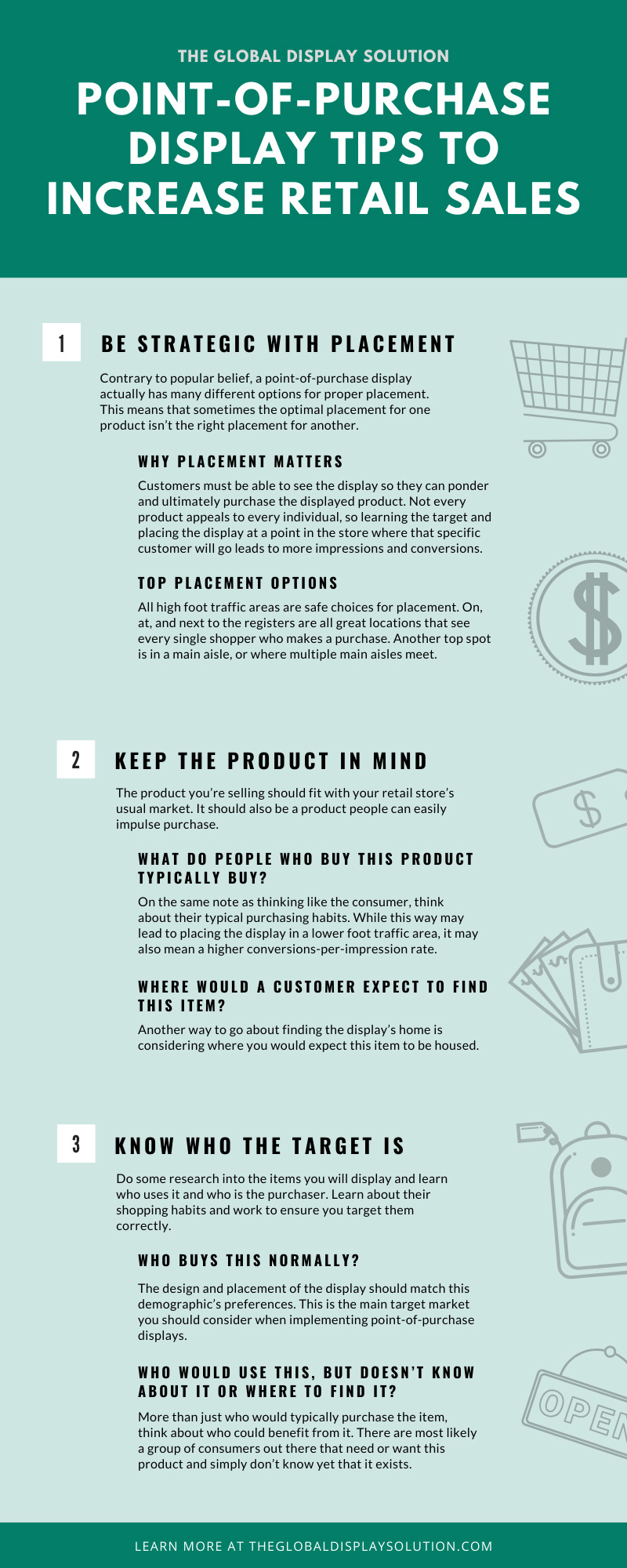Point-Of-Purchase Display Tips to Increase Retail Sales
February 5, 2020, 2:12 am

Point-of-purchase displays are holders for specific products that are housed on, near, or next to a checkout counter. Their purpose is to entice customers to make an impulse purchase by grabbing their attention with ease of purchase, special promotions, special offers, seasonal relevancy, and more.
There are many things to consider when utilizing point-of-purchase displays in your retail store. Many retailers have found increased sales and boosted impulse purchasing with this marketing method. Customers appreciate the ease that comes with having the display so readily available to them while they wait in lines. It also helps to ease the impatience of guests standing in longer lines, since they can shop and explore new products during the wait. There are some dos and don’ts of retail displays to keep in mind, though. Check out these helpful point-of-purchase display tips to increase retail sales.
Be strategic with placement
Placement matters when it comes to any commercial signage display, especially a point-of-purchase display. Contrary to popular belief, a point-of-purchase display actually has many different options for proper placement. This means that sometimes the optimal placement for one product isn’t the right placement for another. Finding the placement that makes the most conversions is the goal.
Why placement matters
Placement is extremely important when using point-of-purchase displays. Customers must be able to see the display so they can ponder and ultimately purchase the displayed product. More important than just any customers seeing it, the right customers must see it. Not every product appeals to every individual, so learning the target and placing the display at a point in the store where that specific customer will go leads to more impressions and conversions.
Top placement options
There are a few spots within a retail shop that are popular for more general demographics and products that appeal to a wide audience. All high foot traffic areas are safe choices for placement. On, at, and next to the registers are all great locations that see every single shopper who makes a purchase. Another top spot is in a main aisle, or where multiple main aisles meet. Main aisles see many more people than smaller aisles do, and crossroads see the most. When in doubt of where to place a point-of-purchase display, opt for an area with ample guaranteed foot traffic.
Think like the consumer
Sometimes, those running a business can get too caught up in metrics and standards. Often, simply thinking like a consumer can answer the toughest business questions. You are a consumer—maybe not while you’re working, but chances are you’ve made a few personal purchases at a retail shop in your lifetime. Think back to your personal experience as a customer. Were there times you saw point-of-purchase display and were driven to make an impulse purchase? If so, mimic this location or find one similar.
Keep the product in mind
Not every point-of-purchase display product will appeal to the same target market. Keep the product in mind when choosing where to place the display. The product you’re selling should fit with your retail store’s usual market. It should also be a product people can easily impulse purchase.
What do people who buy this product typically buy?
On the same note as thinking like the consumer, think about their typical purchasing habits. The person that will impulse buy the product in your point-of-purchase display came into the store for something. Figure out that something and put the display nearby it. While this way may lead to placing the display in a lower foot traffic area, it may also mean a higher conversions-per-impression rate.
Where would a customer expect to find this item?
Another way to go about finding the display’s home is considering where you would expect this item to be housed. For example, if most of your customers come into your shop for your cozy sweaters, but your point-of-purchase display will house affordable and fun phone accessories, placing these two together might seem out of place. Instead, try placing the display near other electronic items or even near a register for a last-minute purchase.
Is the item something somebody would purchase on an impulse?
Make sure the item you’re displaying is something customers would buy without extreme consideration. If the item is too expensive, they may want to go home, think about it, talk to their partner, and ultimately not make the purchase. If the item is too obscure, they may have trouble envisioning themselves using it. The product should be useful, intriguing, and a fair price to encourage the most impulse purchases as possible.
Know who the target is
Know who you are targeting. Do some research into the items you will display and learn who uses it and who is the purchaser. Learn about their shopping habits and work to ensure you target them correctly. A display that appeals to its target market is a successful display. A lot of this information can be easily found in consumer studies, from focus groups, and from purchasing data from previous years at similar retail locations.
Who buys this normally?
Ask yourself who typically purchases the product in the display. The design and placement of the display should match this demographic’s preferences. This is the main target market you should consider when implementing point-of-purchase displays.
Who would use this, but doesn’t know about it or where to find it?
More than just who would typically purchase the item, think about who could benefit from it. There are most likely a group of consumers out there that need or want this product and simply don’t know yet that it exists. Take this as a task. Do your duty by introducing them to the product they’ve literally been looking for. This information is a bit harder to come by than simply looking at studies. You have to think about the product and its many uses. Then, think about each individual you know personally that would use it. Consider what those people typically shop for and make the placement strategic from there.


